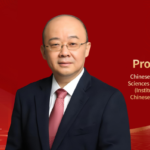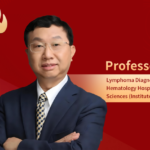From January 5th to 7th, 2024, the 4th China/Academy of Hematology Sciences Development Conference (CASH) was grandly held in Tianjin. Continuing with the theme "Comprehensive Hematology, Healthcare, and Wellness", this conference focused on the core development directions in hematology and explored the major academic issues in basic hematology research, translation, and clinical diagnosis and treatment in the new era. Among the highlights was a presentation on "Hemophilia Gene Therapy Using AAV as a Vector" by Professor Lei Zhang , Vice Secretary of the Party Committee and Secretary of the Discipline Inspection Committee at the Institute of Hematology, Chinese Academy of Medical Sciences (CAMS). To gain deeper insights into this field, "Oncology Frontier - Hematology Frontier" interviewed Professor Zhang at the conference, offering an in-depth analysis of gene therapy for hemophilia.
“Oncology Frontier – Hematology Frontier“: In recent years, gene therapy mediated by adeno-associated virus (AAV) has made significant breakthroughs in the treatment of hemophilia. Could you please start by explaining the mechanism of this gene therapy?
Professor Lei Zhang : Currently, gene therapy using AAV as a vector has become one of the hottest research directions. The number of related basic and clinical studies is continually increasing. Clinical research primarily focuses on genetic diseases, including blood disorders (like hemophilia), central nervous system and neuromuscular diseases, and ophthalmic diseases. Several clinical trials have been hugely successful, and some AAV gene therapies have been approved by the FDA for clinical treatment.
Regarding the mechanism, in the treatment of hemophilia, gene therapy using adeno-associated virus (AAV) as a vector involves transporting factor VIII or IX to the liver cells of hemophilia patients. This therapy injects factor VIII or IX into the hepatic parenchymal cells, and the carried gene fragment contains a liver-specific promoter, which activates the relevant genes. This process produces the factor VIII or IX that hemophilia patients lack, achieving a therapeutic effect.
“Oncology Frontier – Hematology Frontier“: Could you discuss the efficacy of AAV-mediated gene therapy in the treatment of hemophilia?
Professor Lei Zhang : Hemophilia types A (factor VIII deficiency) and B (factor IX deficiency) are X-chromosome linked hereditary diseases. They can be categorized as mild, moderate, or severe based on the severity of the condition. Patients with severe hemophilia lack factors VIII and IX, leading to recurrent, lifelong bleeding events. They require long-term external supplementation of these factors as replacement therapy. Without it, repeated bleeding can cause disability or even be fatal. Although transfusion of clotting factors remains the primary treatment for hemophilia, it brings a substantial economic burden and less than satisfactory quality of life. Addressing these issues, research exploring gene therapy using AAV as a vector in hemophilia began in 2011. A study in the United States enrolled 10 patients with hemophilia B and treated them with this gene therapy. After over a decade of follow-up, results showed that gene therapy using AAV as a vector is safe and highly effective in hemophilia patients. Patients with hemophilia B were able to stably express factor IX over a long period post-treatment, indicating that this gene therapy could achieve long-term curative effects in patients with hemophilia B. However, whether this therapy can provide a lifetime cure still requires further observation. Moreover, ongoing clinical studies aim to modify AAV to enhance efficacy and safety, with the goal of achieving a lifelong cure.
“Oncology Frontier – Hematology Frontier“: Please share some of the significant advancements your team has made in AAV-mediated gene therapy and your future plans.
Professor Lei Zhang : Compared to international standards, China’s research pace in gene therapy for hemophilia has been relatively slower. Our team started AAV-mediated gene therapy for hemophilia in 2019. We included 10 adult patients with severe/moderately severe hemophilia B in our study. After receiving prophylactic corticosteroid treatment (to avoid gene expression decline or loss) for a week, patients were administered a single infusion of BBM-H901 (carrying the FIX-Padua gene). The data showed rapid, robust, and lasting gene expression. The increase in FIX:C translated into significant clinical benefits, reducing bleeding events and the need for clotting factor infusions in patients. Subsequently, this study was published in the New England Journal of Medicine (NEJM) and The Lancet Haematology, receiving recognition from international experts in hemophilia gene therapy. They acknowledged that China’s hemophilia gene therapy has reached a world-class level. Currently, China has over 10 registered clinical studies on hemophilia gene therapy, with more than 100 hemophilia patients receiving this treatment, most showing promising results. Moving forward, we will conduct in-depth research on improving AAV and gene transduction, aiming to position China’s hemophilia gene therapy among the world’s best.

Professor Lei Zhang
- Doctor of Medicine, Chief Physician, Doctoral Supervisor
- Vice Secretary of the Party Committee, Secretary of the Discipline Inspection Committee, and Deputy Director of the Thrombosis and Hemostasis Diagnosis and Treatment Center at the Institute of Hematology, Chinese Academy of Medical Sciences (CAMS)
- Director of the Key Laboratory of Gene Therapy, Chinese Academy of Medical Sciences
- Director of the Tianjin Key Laboratory of Blood Disease Gene Therapy
- Committee Member of the Hemostasis and Thrombosis Group, Hematology Branch, Chinese Medical Association (Eighth and Ninth Terms)
- Youth Committee Member of the Hematology Society, Chinese Physiological Society
- Committee Member of the Precision Medicine Hematology Branch, Chinese Medical Doctor Association
- Committee Member of the Integrated Medicine Physician Branch, Chinese Doctor Association
- Committee Member of the Cell Therapy Committee, Chinese Society of Blood Transfusion
- Executive Committee Member of the Stem Cell Engineering Technology Branch, Chinese Society of Biomedical Engineering
- Committee Member of the Hemostasis and Thrombosis Branch, Chinese Medical Education Association
- Standing Committee Member of the Hematology Branch, Tianjin Medical Association
- Council Member of the Tianjin Physiological Sciences Society
- Member of the Tianjin Stem Cell Clinical Research Expert Committee
- Leading Talent (Ten Thousand Talents Plan) of the Ministry of Science and Technology, Outstanding Contribution Middle-Aged and Young Expert of the National Health Commission, “Peking Union Scholar” Distinguished Professor, First “Tianjin Medical Talent,” Leader of the 2016 Peking Union Innovative Team and the 2016 Tianjin Innovative Team
- Editorial Board Member of the Chinese Edition of Haemophilia, Official Magazine of the WFH, and Corresponding Editorial Board Member of the Chinese Journal of Hematology
- Principal Investigator of 15 research funds; Author of over 100 papers, Applicant of 4 patents; Recipient of 1 national-level award and 5 provincial/ministerial-level awards.


